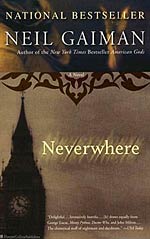
![]() SueCCCP
SueCCCP
1/1/2013
![]()
The book is the novelized version of a TV show, written for the BBC and shown in 1996, which I had actually seen and been impressed by. In many ways, the book's origins are pretty obvious, because it has a very visual quality and is very 'busy' with lots of movement and a large cast. Ultimately, this leads to a few too many ideas, locations and characters, which left me with questions unanswered at the end of the book. However, it is wildly imaginative and will keep you guessing for every step of the way.
Perhaps the most striking thing about this book is the world building. At first, London Below seems to be simply an underground society of the dispossessed and forgotten. But, as we travel further in and further down, we come across increasingly magical and fantastical elements until we almost feel as if we are in Alice's Wonderland or Dorothy's Oz. Many of the inhabitants of this world appear to be normal humans, but they may have amazing talents or be the relics of a previous time period. One very disturbing feature of London Below is that entering into it causes your life in London Above to unravel. Once Richard has been drawn into the world he finds that the people above have forgotten his existence and cannot really 'see' him anymore. This makes it a cruel and hopeless world in many ways, so that it seems more nightmare than dream.
Many of the major characters are very gray in terms of their motivation. Although we are sure that Richard and Door are the 'good guys', many of the other characters are much more doubtful. For example, the Marquis is a very difficult character to trust. Door trusts him totally, but throughout the first part of the book we are constantly given reason to doubt his loyalty and to suspect him of playing a double agent. We see something similar with Messers Croup and Vandemar. Yes, they are exceedingly dangerous murderers and Mr Vandemar eats raw animals, is immune to pain and has spit like superglue, but they are simply mercenaries. They do what they are paid to do, although they do enjoy it rather too much. This uncertainty about some of the characters was very refreshing and made them feel so much more real than if they had been written as the usual two-dimensional offerings.
Indeed, even the central figures of Richard and Door are not typical either. Door is not a helpless maiden in distress in need of rescuing. This is fortunate, because Richard is most certainly not a knight in shining armor. He is full of self-doubt and desperately wants to return to his old life. However, we see him grow and come to realize that he has more strength than he had ever realized. During the journey we share his sense of disbelief and of being off-balance. He questions what he sees and so do we as we see the world through his eyes.
The plot was basically a quest journey, so it followed a predictable path in its broadest outline. However, there were enough twists and turns to keep me guessing at what was coming next. There were also moments of high tension and deep despair, so that I wanted to know how they escaped from the latest trap or problem. But, in many ways, the plot took a bit of a back seat to the world building and the introduction of new and interesting characters.
Overall, this was a fun read, although I felt like it was a little lacking in depth. I would have preferred fewer characters and settings so that we could have learnt more about each of them. I do wonder if the original idea was for more than one series. I am left with far too many questions and ideas that I want to explore, which is vaguely dissatisfying.
For my complete review, click the link below:
http://coffeecookiesandchilipeppers.blogspot.com/2012/07/neverwhere-by-neil-gaiman.html